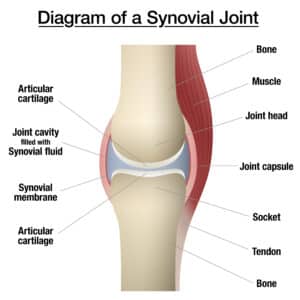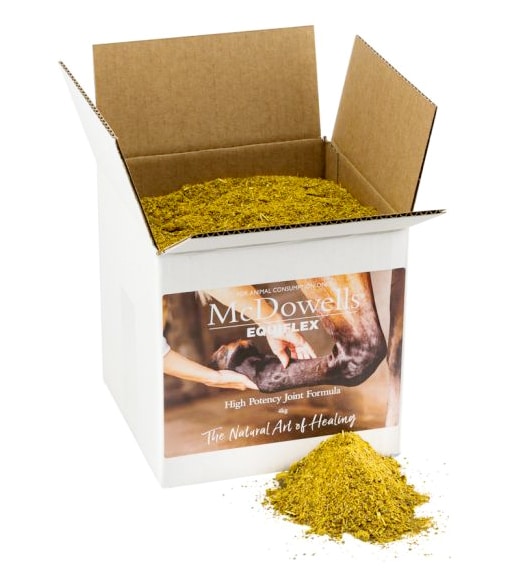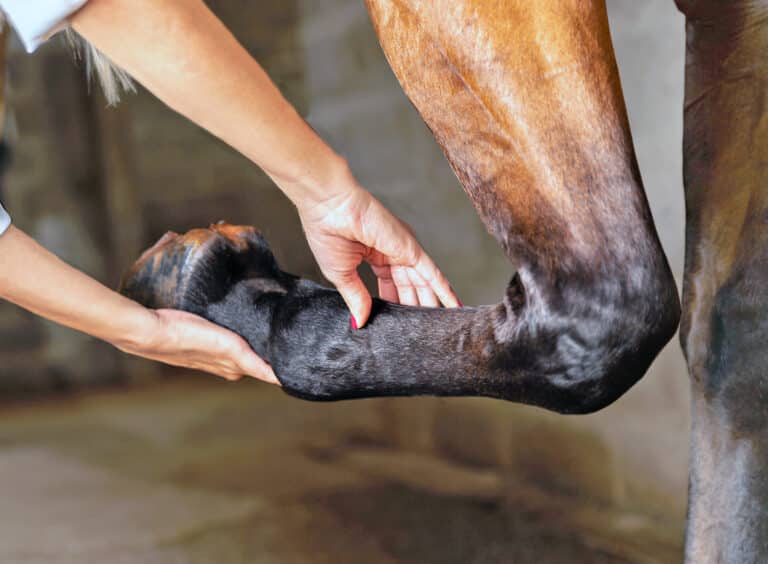Horses have three different types of joints: fibrous, cartilaginous, and synovial. Often joint problems are seen as an issue for older horses, but our focus should be on supporting joint health throughout a horse’s life.
The first type of joint is the fibrous joint. These are immobile joints found between the bones in your horse’s skull and between the shafts of some long bones. They do not move and are therefore less likely to cause issues.
The second type is the cartilaginous joint. Examples of these are the joints in a horse’s spine, pelvis and growth plates. They also have limited movement.
The third type is the synovial joint. These make up the majority of joints in a horse’s leg. There are six different kinds of synovial joints, and a total of 18 in your horse’s body. They have the most movement and are more likely to suffer from disease and injury.
But a joint is more than simply the union of two or more bones; the joint is also considered an organ. (1)
The synovial joint has a space in which the synovial fluid lies. This fluid bathes the joints and tendons, lubricates the joints, absorbs impact, and is like a joint ‘oil’. It also provides growth factors, oxygen, and nutrition for the joint. And don’t forget the synovial membrane, the lining along the inner surface of the joint capsule.

There are 205 bones in the horse’s skeleton. Twenty of these bones are in each foreleg and 20 in each hind limb. (2) These are connected through tendons, ligaments, and cartilage. Joints can become damaged through abnormal forces acting on normal cartilage, or normal forces acting on abnormal cartilage. (1)
Joint health should be a consideration for all horse owners: for performance horses; general riding horses; young, growing horses; and our oldies. Their joints are largely responsible for their general wellbeing and quality of life.
So, how can you ensure that every joint has the nutrition it needs to function optimally?
Diet and nutrition
Feeding and care for the joints is vital for horses. (3) It is essential that the base diet contains the right trace minerals, vitamins and fatty acids. Proper nutrition, from gestation and beyond, will ensure joints remain healthy for as long as possible.
Keeping your horse at an average ideal weight means there’s less impact and demand on joints. If a horse is carrying extra weight, there will be increased stress on the joints.
Exercises for joint health
The best exercises for joint health are low-impact activities that promote range of motion, flexibility, and muscle strength without putting excessive stress on the joints. These include:
Walking (ridden or in-hand) can help to maintain joint flexibility and mobility. It’s also a good warm-up exercise before more strenuous activities.
Trotting improves cardiovascular fitness and builds muscle strength.
Hill work improves muscle strength and joint mobility, and helps to strengthen the back and hindquarters.
Pole work improves balance, coordination and flexibility, and encourages the horse to move their joints through a full range of motion.
Remember to warm your horse up before any exercise and gradually increase the intensity of the workout over time. Give your horse regular rest days and avoid overworking them, which can put unnecessary strain on their joints. Stretching exercises can also be helpful for maintaining joint flexibility and preventing stiffness.
Confirmation
Poor confirmation can cause pressure on the joints and impact overall biomechanics. For example, horses with straighter hind limbs are less able to absorb shock and are more likely to suffer strain on their hocks. Horses with straight shoulders may experience more concussion and strain on their front legs, particularly the knee and fetlock joints. Proper hoof care and regular trimming is important for overall equine health and can also help reduce stress on the joints.
McDowells recommendation
Most people feeding joint supplements are used to seeing artificial looking white powders. That’s why McDowells formulated EquiFlex. It combines the best in herbal medicine with the best science available. Equiflex is a high potency joint formula, a combination of modern connective tissue supplements such as MSM and glucosamine with the added benefits of traditional herbal medicine. (4) EquiFlex is designed to encourage repair by providing targeted nourishment to joints, tendons, ligaments and cartilage. This product is natural and has a focus on the highest quality, most effective ingredients we could source.

Ingredient Breakdown
MSM (Methylsulfonylmethane): There is a lot of research to support claims that MSM reduces joint pain and acts as an anti-inflammatory. It is a rich source of organic sulphur that aids in reduced muscle damage, reducing pain and stiffness, and in boosting immunity. It is vital for soft tissue growth, and is required in the synthesis of bones to connective tissue.
Glucosamine: Used by the body to make the chemicals that build tendons, ligaments, cartilage, and the fluid that surrounds joints. Its production of GAGs (glucosaminoglycans) in synovial fluid enhances lubrication.
Equihemp: Contains both omega-3 and omega-6 fatty acids with a 1:3 ratio. Fatty acids are essential for the normal functioning of cells.
Turmeric: Able to reduce inflammation and the associated pain substantially when added to your horse’s diet along with pepper.
Rosehips: One of the very best sources of natural Iron and Vitamin C. Rosehips also contain biotin for optimum hoof health.
Yarrow: Counters tissue swelling and inflammation and encourages bone marrow health.
Meadowsweet: Traditionally used to reduce acids in the body including in the area around the joints.
With a combination of modern connective tissue supplements such as MSM and glucosamine, plus the added benefits of traditional herbal medicine, EquiFlex is designed to provide effective nourishment and nutrition to joints, tendons, ligaments and cartilage.
For more information on EquiFlex and McDowells full range of equine health products, visit their website.
References
- Synovial Joints and How They Work – The Horse.
- Feeding Horses for Joint Health – The Horse.
- Plant Bioactives and Extracts as Feed Additives in Horse Nutrition, Journal of Equine Veterinary Science, Vol. 69, pp. 66-67.



